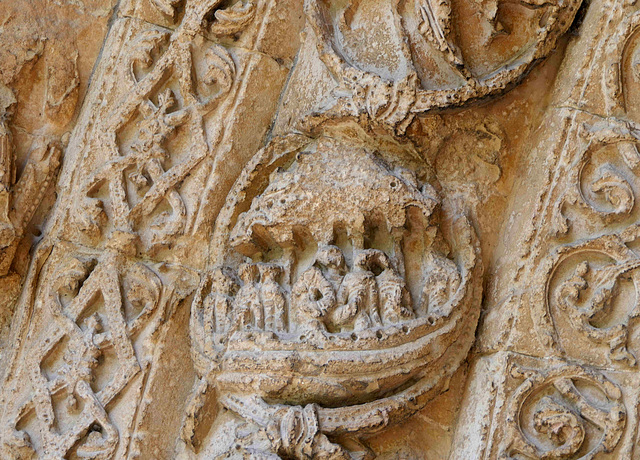Salisbury - Cathedral
Tangermünde - St. Stephan
Florence - Battistero di San Giovanni
Modena - Duomo
Venezia - Basilica di San Marco
Venezia - Basilica di San Marco
Beaune - Collégiale Notre-Dame de Beaune
Otranto - Cattedrale di Otranto
Girona - Cathedral of Saint Mary
Monreale - Duomo di Monreale
Saint-Savin - Saint-Savin
Saint-Savin - Saint-Savin
Tudela - Catedral de Santa Maria
Location
See also...
Keywords
Authorizations, license
-
Visible by: Everyone -
All rights reserved
-
19 visits
Malmesbury - Abbey


Malmesbury, the oldest borough in England, became the site of Malmesbury Abbey, a monastery famed for its learning. It was later home to one of Alfred the Great's fortified castles (burhs) for defence against the Vikings. As a market town, it became prominent in the Middle Ages as a centre for learning, focused on and around the abbey.
In the later seventh century, the site of the Abbey was chosen by Máel Dub, an Irish monk who established a hermitage. Towards the end of his life Malmesbury Abbey was founded around 676 by Aldhelm, a nephew of King Ine of Wessex. The town of Malmesbury grew up around the expanding Abbey.
In October 939 Æthelstan, king of Wessex and of the English, died in Gloucester, and in the year 941 his remains were buried in the Abbey.
The Abbey developed an illustrious reputation for academic learning under the rule of abbots such as Aldhelm, John Scotus Eriugena, Alfred of Malmesbury and Aelfric of Eynsham.
The current Abbey was substantially completed by 1180. The 131 m tall spire, and the tower it was built upon, collapsed around 1500 destroying much of the church, including two-thirds of the nave and the transept.
The abbey was closed at the Dissolution of the Monasteries in 1539 by Henry VIII and was sold to William Stumpe, a rich merchant. He returned the abbey church to the town for continuing use as a parish church, and filled the abbey buildings with up to 20 looms for his cloth-weaving enterprise.
During the English Civil War, Malmesbury suffered extensive damage evidenced by hundreds of pock-marks left by bullets.
Cluny did strongly influence the artistic style here. The connection to Cluny was close. Abbot Peter Moraunt had been a monk of Cluny and had been for a time Prior of La Charité.
Unfortunately the carvings of the portal are very weathered. Seen here may be Noah's Ark
In the later seventh century, the site of the Abbey was chosen by Máel Dub, an Irish monk who established a hermitage. Towards the end of his life Malmesbury Abbey was founded around 676 by Aldhelm, a nephew of King Ine of Wessex. The town of Malmesbury grew up around the expanding Abbey.
In October 939 Æthelstan, king of Wessex and of the English, died in Gloucester, and in the year 941 his remains were buried in the Abbey.
The Abbey developed an illustrious reputation for academic learning under the rule of abbots such as Aldhelm, John Scotus Eriugena, Alfred of Malmesbury and Aelfric of Eynsham.
The current Abbey was substantially completed by 1180. The 131 m tall spire, and the tower it was built upon, collapsed around 1500 destroying much of the church, including two-thirds of the nave and the transept.
The abbey was closed at the Dissolution of the Monasteries in 1539 by Henry VIII and was sold to William Stumpe, a rich merchant. He returned the abbey church to the town for continuing use as a parish church, and filled the abbey buildings with up to 20 looms for his cloth-weaving enterprise.
During the English Civil War, Malmesbury suffered extensive damage evidenced by hundreds of pock-marks left by bullets.
Cluny did strongly influence the artistic style here. The connection to Cluny was close. Abbot Peter Moraunt had been a monk of Cluny and had been for a time Prior of La Charité.
Unfortunately the carvings of the portal are very weathered. Seen here may be Noah's Ark
Marco F. Delminho, Don Sutherland, Paolo Tanino and 2 other people have particularly liked this photo
- Keyboard shortcuts:
Jump to top
RSS feed- Latest comments - Subscribe to the comment feeds of this photo
- ipernity © 2007-2024
- Help & Contact
|
Club news
|
About ipernity
|
History |
ipernity Club & Prices |
Guide of good conduct
Donate | Group guidelines | Privacy policy | Terms of use | Statutes | In memoria -
Facebook
Twitter

Sign-in to write a comment.